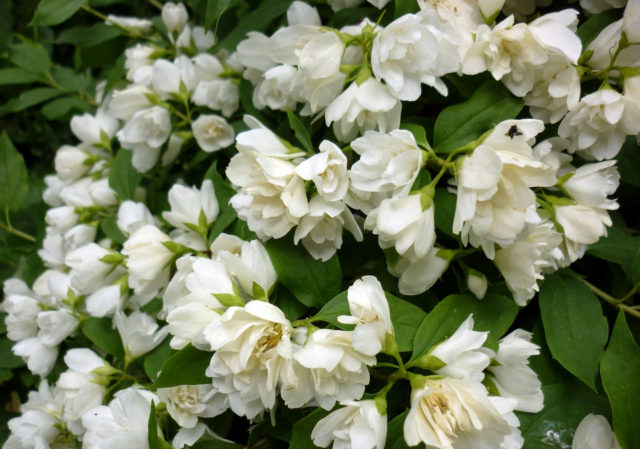Content
Mock orange Lemoine is a rich variety of varieties of the hybrid category, created by the French breeder V. Lemoine in the 19th century on the basis of an ordinary and small-leaved species of a common garden shrub. In front gardens there are various specimens of mock orange, because its numerous species have long been cultivated. Nurseries sell ancient and modern varieties of the mock orange hybrid Lemoinei, which differ slightly in the subtleties of care.
Description of Lemoine mock orange
The spreading bush is distinguished by a large number of arched shoots, which in different varieties reach from 1 to 3 m in height. The trunks have a smooth grayish-brown bark that cracks with age, and are quite thin and flexible. Multi-stemmed Lemoine mock orange bushes, as in the photo, are of medium density, with a crown width of up to 1.5-2 m.The length of the light green ovoid leaves is 4-7 cm. The light and at the same time rich shade of foliage gives the bush a picturesque appearance even after flowering.
How Jasmine Lemoine blooms
Loose inflorescences of 5-9 buds are formed on short lateral shoots. The flowers are large, cup-shaped, from 2 to 4 cm in diameter, they are simple, with 4-5 beautifully concave petals, semi-double and double. The color of the corolla is predominantly white; there are Lemoine mock oranges with milky cream shades, as well as with burgundy-pink tints in the center. The visual lightness of the flowers is given by the combination of large, gracefully curved petals and long yellow-cream stamens. The flowers of most varieties have an intense scent. The buds of different varieties bloom from mid to late June. Flowering usually lasts 10-20 days.
Abundant flowering of all varieties of Lemoine mock orange is ensured by fulfilling the following planting conditions:
- the bushes are located in a sunny place, only light short-term partial shade is allowed;
- fertile, loose soil.
The most common varieties
Most of the forms of the bred hybrid belong to the author, Victor Lemoine; these are about 40 varieties obtained at the end of the 19th and beginning of the 20th centuries. New mock oranges have spread from France throughout the world. Many varieties of Lemoine are grown in our country, taking into account climatic conditions. There may be a minimal difference in size between the photo and description of Lemoine mock oranges, which grow in gardens in the middle zone.Frosts have a detrimental effect on the growth of bushes. All other characteristics are completely consistent.
Ermine Robe
Lemoine mock orange Manteau d'Hermine (Manto d'Hermine), 75-90 cm high, bred in 1899, was named because of its abundant and long flowering - up to a month or more. It blooms with white, semi-double buds 2-3 cm wide, which densely cover the bush against the background of small foliage.
Belle Etoile
The mock orange Lemoine Belle Etoile (Beautiful Star) has a special attraction of simple flowers - petals with a carmine-purple center and a light strawberry aroma. The bush, obtained by the son of V. Lemoine, Emile Lemoine, grows in the middle zone up to 1 m, requires shelter in snowless winters, since it can only withstand - 23 ° C.
Girandole
The variety Girandole (Chandelier) captivates with its wide crown, up to 120 cm in diameter, with drooping shoots 150 cm high, and double, creamy-white flowers with a delicate aroma. Mock orange is resistant, tolerates frosts down to 30 °C.
Erectus
The shoots of the mock orange Lemoine Erectus, in accordance with its name, are straight and low - 1.2-1.5 m. Only with age do the branches bend smoothly. The white flowers, 2.5-3 cm in diameter, are simple and emit a strong aroma. The variety is frost-resistant and sun-loving. For lush flowering, it is recommended to remove old shoots every 4-5 years.
Dame Blanche
The shape of the mock orange variety Dame Blanche (Lady in White) belongs to the dwarf category, the shoots are 80-90 cm long. But the diameter of the spreading bush is almost twice as wide as its height. Very fragrant semi-double flowers, with snow-white petals. The corollas are large - 3.5-4 cm wide.Dame Blanche blooms from the last days of June and in July.
Schneestorm
Chubushnik Lemoine Schneesturm (Snowstorm) - spreading and tall, up to 2-2.5 m. Bush width - 1.20-1.40 m. During flowering, which occurs in June, the tops of the shoots, heavy under the tassels of buds, smoothly bend down . White, large, multi-petaled flowers reach 4-5 cm in diameter. A subtle sweet aroma emanates from the inflorescences. The variety is unpretentious, winter-hardy.
Minnesota Snowflake
According to reviews, the mock orange Lemoine Minnesota Snowflake is popular. Powerful erect shoots of the variety form an oval vertical crown up to 2 m high and 1.5 m in diameter. Dark green large leaves create an expressive background for snow-white double flowers, collected in clusters of several pieces. The diameter of the corolla is up to 2.5 cm. The variety is early, the buds begin to bloom in May. It is preferable to buy mock orange seedlings Lemoine Minnesota Snowflake in a tube. Such packaging will ensure safe transportation of the roots.
Sun
The dwarf mock orange variety Solnyshko has been included in the State Register since 2011, the applicants are the Moscow and St. Petersburg Botanical Gardens. A bush with an oval-vertical crown, height from 30 to 45 cm, width up to 30 cm. Shoots are straight, with grayish bark. A non-flowering variety, intended for decoration of rocky gardens and container culture. The yellow-green leaves are jagged and look expressive and bright in spring and early summer.
Main characteristics
A popular landscape shrub, rich in different varieties, created by the Lemoine family and other breeders, withstands the winters of the middle zone quite steadfastly. When purchasing seedlings, it is worth checking the correct name of the variety to determine its frost resistance. There are specimens that overwinter without shelter.After severe frosts, most mock orange trees grow well and grow green mass and wood. But some foreign varieties are heat-loving and suffer greatly in winter.
Mock oranges are not susceptible to common diseases, but the leaves are plagued by various pests. Insecticides are used against insects.
Features of reproduction
Varietal characteristics are not completely transmitted through seeds; various variations will follow. Seeds are sown after stratification or before winter, after the soil freezes. The shrub is easy to grow if the climate suits the varieties.
Mock orange is most often propagated vegetatively:
- cuttings, green or lignified, with small-leaved varieties being better for cuttings;
- a more accessible way is layering;
- The most effective way is to divide the bush.
Planting and care
The shrub is easy to grow if the climate suits the varieties.
Recommended timing
The best time to plant mock orange is spring or early autumn. The bushes are planted in the fall at such a time that there are 20 days left before frost, during which the plant has time to take root. Seedlings in containers are moved from nurseries until the end of June.
Site selection and soil preparation
Mock orange is undemanding to the type of soil; it cannot be planted only in marshy and saline areas. The main condition for good development and abundant flowering is a sunny place or light partial shade for 3-4 hours. A planting hole measuring 50x60 cm can be prepared in advance by laying drainage and mixing garden soil with sand, clay, compost or humus. Additives depend on soil type. For successful growth, add 70-90 g of complex fertilizer for flowering shrubs.
Landing algorithm
A mock orange seedling is placed on the prepared substrate:
- the root collar can be deepened by only 1-1.5 cm;
- The tree trunk circle is watered with 10-12 liters of water and mulched.
Growing rules
Caring for most varieties of Lemoine mock orange is simple.
Watering schedule
Seedlings are watered once a week, especially in dry summers. Adult bushes - once every 18-20 days, 15-25 liters per bush. In case of heavy natural precipitation, watering is not carried out.
Weeding, loosening, mulching
The non-mulched circle of mock orange tree trunks is systematically loosened and weeds are removed. For mulch, use peat, dry grass, and bark.
Feeding schedule
Fertilizers promote the growth of mock orange and beautiful flowering:
- the first fertilizing is carried out early in April with preparations containing nitrogen or humus;
- before the creation and blooming of buds, the bushes are supported with complex mineral fertilizers;
- In July-August, potassium-phosphorus agents are added.
Trimming
For mock oranges, sanitary pruning is required. Bushes are formed if you don’t like the silhouette of the crown. Every 4-5 years, old shoots are removed, and to rejuvenate the plant, the remaining 3-4 shoots are shortened to 40 cm.
Preparing for winter
Adapted varieties can tolerate sub-zero temperatures without shelter. In autumn, the branches are tied so that they are not damaged by the mass of snow. Heat-loving varieties wrap up, especially in the first years.
Pests and diseases
Mock oranges are not susceptible to diseases, but the delicate leaves are often damaged by insects. Spraying with insecticides is used against leaf-eating pests:
- Decis;
- Kinmiks;
- Apollo.
Conclusion
Mock orange Lemoine is an undemanding, beautiful plant that will create a gentle and romantic corner in the garden. Fragrant and spectacular inflorescences against a backdrop of bright greenery will leave an unforgettable summer experience.

















